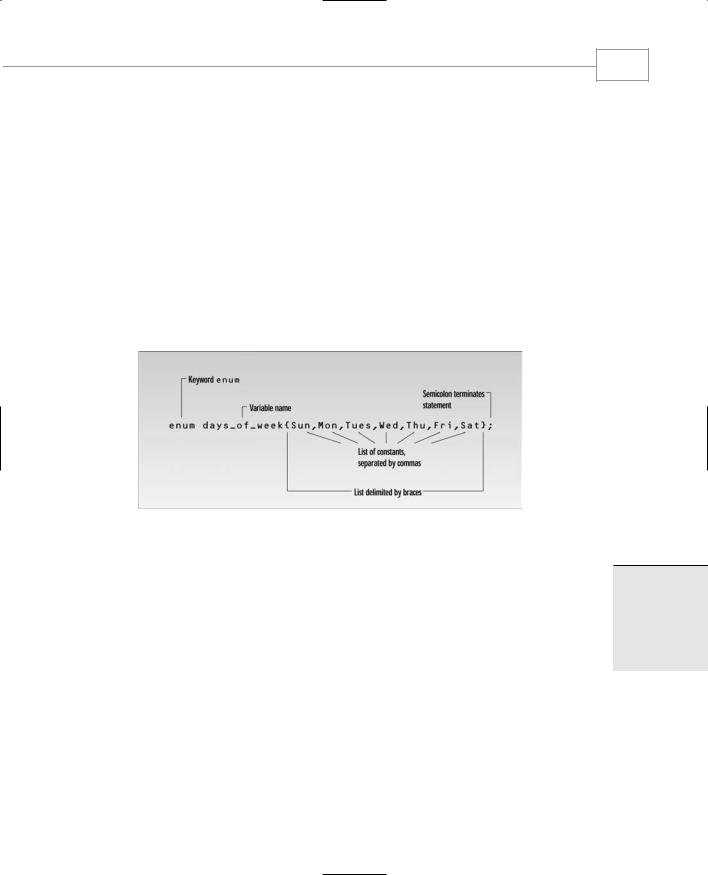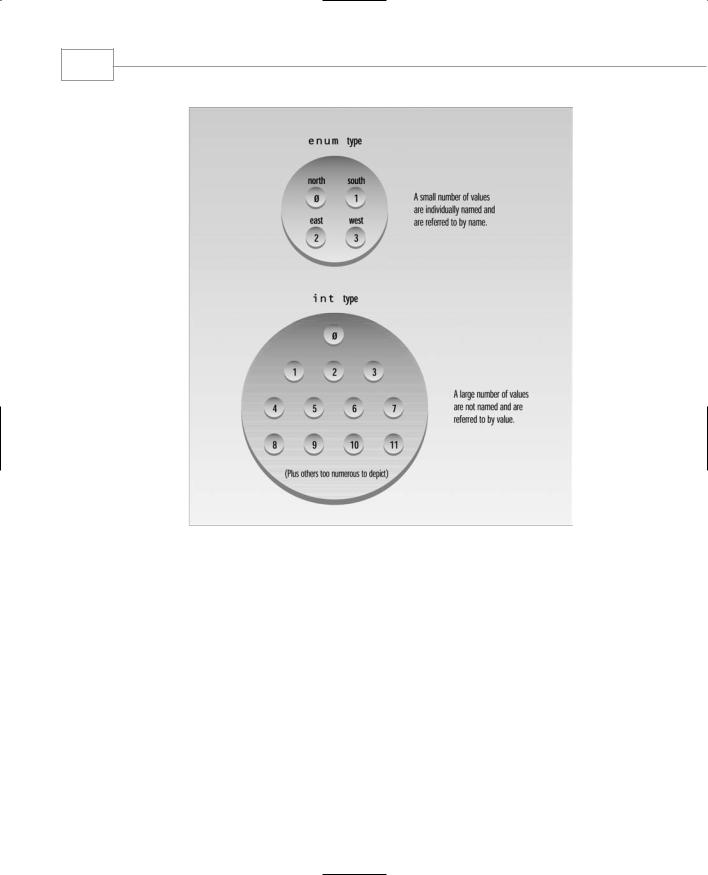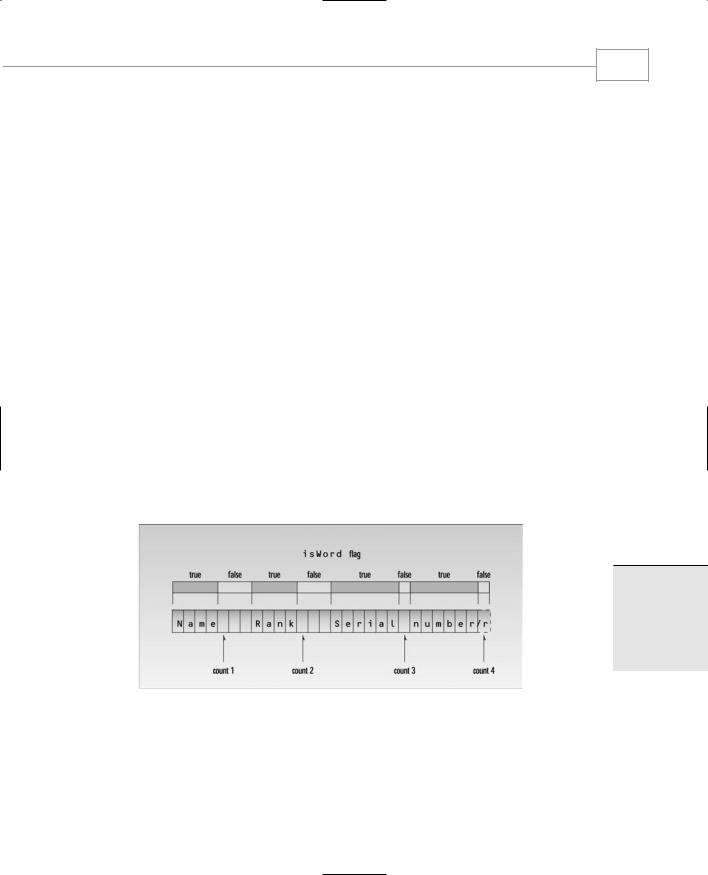
lafore_robert_objectoriented_programming_in_c
.pdf
Structures
145
and the second to
{10, 0.0}
These two Distance values are then used to initialize the Room variable; again, they are surrounded with braces and separated by commas.
Depth of Nesting
In theory, structures can be nested to any depth. In a program that designs apartment buildings, you might find yourself with statements like this one:
apartment1.laundry_room.washing_machine.width.feet
A Card Game Example
Let’s examine a different kind of example. This one uses a structure to model a playing card. The program imitates a game played by cardsharps (professional gamblers) at carnivals. The cardsharp shows you three cards, then places them face down on the table and interchanges their positions several times. If you can guess correctly where a particular card is, you win. Everything is in plain sight, yet the cardsharp switches the cards so rapidly and confusingly that the player (the mark) almost always loses track of the card and loses the game, which is, of course, played for money.
Here’s the structure the program uses to represent a playing card:
struct card
{
int number; int suit; };
This structure uses separate members to hold the number of the card and the suit. The number runs from 2 to 14, where 11, 12, 13, and 14 represent the jack, queen, king, and ace, respectively (this is the order used in poker). The suit runs from 0 to 3, where these four numbers represent clubs, diamonds, hearts, and spades.
Here’s the listing for CARDS:
//cards.cpp
//demonstrates structures using playing cards #include <iostream>
using namespace std;
4
STRUCTURES
const int clubs = 0; |
//suits |
|||
const int diamonds |
= |
1; |
||
const |
int hearts |
= |
2; |
|
const |
int spades |
= |
3; |
|

146 |
Chapter 4 |
|
const int jack = 11; |
//face cards |
|||
const int queen |
= 12; |
|
||
const |
int |
king = 13; |
|
|
const |
int |
ace = |
14; |
|
////////////////////////////////////////////////////////////////
struct |
card |
|
{ |
|
|
int |
number; |
//2 to 10, jack, queen, king, ace |
int |
suit; |
//clubs, diamonds, hearts, spades |
}; |
|
|
////////////////////////////////////////////////////////////////
int main() |
|
|
|
{ |
|
|
|
card temp, chosen, prize; |
//define cards |
||
int position; |
|
|
|
card card1 = { |
7, clubs }; |
//initialize card1 |
|
cout << |
“Card 1 is the 7 of clubs\n”; |
|
|
card card2 = { |
jack, hearts }; |
//initialize card2 |
|
cout << |
“Card 2 is the jack of hearts\n”; |
|
|
card card3 = { |
ace, spades }; |
//initialize card3 |
|
cout << |
“Card 3 is the ace of spades\n”; |
|
|
prize = |
card3; |
//copy this card, to remember it |
|
cout << “I’m swapping card 1 and card 3\n”; temp = card3; card3 = card1; card1 = temp;
cout << “I’m swapping card 2 and card 3\n”; temp = card3; card3 = card2; card2 = temp;
cout << “I’m swapping card 1 and card 2\n”; temp = card2; card2 = card1; card1 = temp;
cout << “Now, where (1, 2, or 3) is the ace of spades? “; cin >> position;
switch (position)
{
case 1: chosen = card1; break; case 2: chosen = card2; break; case 3: chosen = card3; break;
}

Structures
147
if(chosen.number == prize.number && |
// compare cards |
chosen.suit == prize.suit) |
|
cout << “That’s right! You win!\n”; |
|
else |
|
cout << “Sorry. You lose.\n”; |
|
return 0; |
|
} |
|
Here’s some sample interaction with the program:
Card 1 |
is the 7 of |
clubs |
||
Card |
2 |
is the |
jack |
of hearts |
Card |
3 |
is the |
ace of spades |
|
I’m swapping card |
1 |
and |
card 3 |
|||
I’m |
swapping card |
2 |
and |
card |
3 |
|
I’m |
swapping card |
1 |
and |
card |
2 |
|
Now, where |
(1, 2, |
or 3) |
is the ace of spades? 3 |
|||
Sorry. You |
lose. |
|
|
|
|
|
In this case the hapless mark chose the wrong card (the right answer is 2).
The program begins by defining a number of variables of type const int for the face card and suit values. (Not all these variables are used in the program; they’re included for completeness.) Next the card structure is specified. The program then defines three uninitialized variables of type card: temp, chosen, and prize. It also defines three cards—card1, card2, and card3—which it initializes to three arbitrary card values. It prints out the values of these cards for the user’s information. It then sets a card variable, prize, to one of these card values as a way of remembering it. This card is the one whose location the player will be asked to guess at the end of the game.
Next the program rearranges the cards. It swaps the first and third cards, the second and third cards, and the first and second cards. Each time it tells the user what it’s doing. (If you find the program too easy, you can add more such statements to further shuffle the cards. Flashing the statements on the screen for a limited time would also increase the challenge.)
Finally the program asks the player what position a particular card is in. It sets a card variable, chosen, to the card in this position, and then compares chosen with the prize card. If they match, it’s a win for the player; if not, it’s a loss.
Notice how easy swapping cards is.
temp = card3; card3 = card1; card1 = temp;
Although the cards represent structures, they can be moved around very naturally, thanks to the ability of the assignment operator (=) to work with structures.
4
STRUCTURES

Chapter 4
148
Unfortunately, just as structures can’t be added, they also can’t be compared. You can’t say
if( chosen == prize ) |
//not legal yet |
because there’s no routine built into the == operator that knows about the card structure. But, as with addition, this problem can be solved with operator overloading, as we’ll see later.
Structures and Classes
We must confess to having misled you slightly on the capabilities of structures. It’s true that structures are usually used to hold data only, and classes are used to hold both data and functions. However, in C++, structures can in fact hold both data and functions. (In C they can hold only data.) The syntactical distinction between structures and classes in C++ is minimal, so they can in theory be used almost interchangeably. But most C++ programmers use structures as we have in this chapter, exclusively for data. Classes are usually used to hold both data and functions, as we’ll see in Chapter 6, “Objects and Classes.”
Enumerations
As we’ve seen, structures can be looked at as a way to provide user-defined data types. A different approach to defining your own data type is the enumeration. This feature of C++ is less crucial than structures. You can write perfectly good object-oriented programs in C++ without knowing anything about enumerations. However, they are very much in the spirit of C++, in that, by allowing you to define your own data types, they can simplify and clarify your programming.
Days of the Week
Enumerated types work when you know in advance a finite (usually short) list of values that a data type can take on. Here’s an example program, DAYENUM, that uses an enumeration for the days of the week:
//dayenum.cpp
//demonstrates enum types #include <iostream>
using namespace std;
//specify enum type
enum days_of_week { Sun, Mon, Tue, Wed, Thu, Fri, Sat };
int main()
{
days_of_week day1, day2; //define variables //of type days_of_week

Structures
149
day1 = |
Mon; |
//give values to |
day2 = |
Thu; |
//variables |
int diff = day2 - day1; |
//can do integer arithmetic |
|
cout << “Days between = “ << diff << endl; |
||
if(day1 < day2) |
//can do comparisons |
|
cout << “day1 comes before day2\n”; |
||
return |
0; |
|
} |
|
|
An enum declaration defines the set of all names that will be permissible values of the type. These permissible values are called enumerators. The enum type days_of_week has seven enumerators: Sun, Mon, Tue, and so on, up to Sat. Figure 4.8 shows the syntax of an enum declaration.
FIGURE 4.8
Syntax of enum specifier.
An enumeration is a list of all possible values. This is unlike the specification of an int, for example, which is given in terms of a range of values. In an enum you must give a specific name to every possible value. Figure 4.9 shows the difference between an int and an enum.
Once you’ve declared the enum type days_of_week as shown, you can define variables of this type. DAYENUM has two such variables, day1 and day2, defined in the statement
days_of_week day1, day2;
(In C you must use the keyword enum before the type name, as in
enum days_of_week day1, day2;
4
STRUCTURES
In C++ this isn’t necessary.)

Chapter 4
150
FIGURE 4.9
Usage of ints and enums.
Variables of an enumerated type, like day1 and day2, can be given any of the values listed in the enum declaration. In the example we give them the values Mon and Thu. You can’t use values that weren’t listed in the declaration. Such statements as
day1 = halloween;
are illegal.
You can use the standard arithmetic operators on enum types. In the program we subtract two values. You can also use the comparison operators, as we show. Here’s the program’s output:
Days between = 3
day1 comes before day2

Structures
151
The use of arithmetic and relational operators doesn’t make much sense with some enum types. For example, if you have the declaration
enum pets { cat, dog, hamster, canary, ocelot };
then it may not be clear what expressions like dog + canary or (cat < hamster) mean.
Enumerations are treated internally as integers. This explains why you can perform arithmetic and relational operations on them. Ordinarily the first name in the list is given the value 0, the next name is given the value 1, and so on. In the DAYENUM example, the values Sun through Sat are stored as the integer values 0–6.
Arithmetic operations on enum types take place on the integer values. However, although the compiler knows that your enum variables are really integers, you must be careful of trying to take advantage of this fact. If you say
day1 = 5;
the compiler will issue a warning (although it will compile). It’s better to forget—whenever possible—that enums are really integers.
One Thing or Another
Our next example counts the words in a phrase typed in by the user. Unlike the earlier CHCOUNT example, however, it doesn’t simply count spaces to determine the number of words. Instead it counts the places where a string of nonspace characters changes to a space, as shown in Figure 4.10.
4
STRUCTURES
FIGURE 4.10
Operation of the WDCOUNT program.
This way you don’t get a false count if you type multiple spaces between words. (It still doesn’t handle tabs and other whitespace characters.) Here’s the listing for WDCOUNT: This example shows an enumeration with only two enumerators.

Chapter 4
152
//wdcount.cpp
//demonstrates enums, counts words in phrase #include <iostream>
using namespace std;
#include <conio.h> |
//for getche() |
enum itsaWord { NO, YES }; |
//NO=0, YES=1 |
int main() |
|
{ |
|
itsaWord isWord = NO; |
//YES when in a word, |
|
//NO when in whitespace |
char ch = ‘a’; |
//character read from keyboard |
int wordcount = 0; |
//number of words read |
cout << “Enter a phrase:\n”; |
|
do { |
|
ch = getche(); |
//get character |
if(ch==’ ‘ || ch==’\r’) |
//if white space, |
{ |
|
if( isWord == YES ) |
//and doing a word, |
{ |
//then it’s end of word |
wordcount++; |
//count the word |
isWord = NO; |
//reset flag |
} |
|
} |
//otherwise, it’s |
else |
//normal character |
if( isWord == NO ) |
//if start of word, |
isWord = YES; |
//then set flag |
} while( ch != ‘\r’ ); |
//quit on Enter key |
cout << “\n---Word count is |
“ << wordcount << “---\n”; |
return 0; |
|
} |
|
The program cycles in a do loop, reading characters from the keyboard. It passes over (nonspace) characters until it finds a space. At this point it counts a word. Then it passes over spaces until it finds a character, and again counts characters until it finds a space. Doing this requires the program to remember whether it’s in the middle of a word, or in the middle of a string of spaces. It remembers this with the enum variable isWord. This variable is defined to be of type itsaWord. This type is specified in the statement
enum itsaWord { NO, YES };
Variables of type itsaWord have only two possible values: NO and YES. Notice that the list starts with NO, so this value will be given the value 0—the value that indicates false. (We could also use a variable of type bool for this purpose.)

Structures
153
The isWord variable is set to NO when the program starts. When the program encounters the first nonspace character, it sets isWord to YES to indicate that it’s in the middle of a word. It keeps this value until the next space is found, at which point it’s set back to NO. Behind the scenes, NO has the value 0 and YES has the value 1, but we avoid making use of this fact. We could have used if(isWord) instead of if(isWord == YES), and if(!isWord) instead of if(isWord == NO), but this is not good style.
Note also that we need an extra set of braces around the second if statement in the program, so that the else will match the first if.
Another approach to a yes/no situation such as that in WDCOUNT is to use a variable of type bool. This may be a little more straightforward, depending on the situation.
Organizing the Cards
Here’s our final example of enum types. Remember that in the CARDS program earlier in this chapter we defined a group of constants of type const int to represent a card’s suits.
const int clubs = 0; const int diamonds = 1; const int hearts = 2; const int spades = 3;
This sort of list is somewhat clumsy. Let’s revise the CARDS program to use enumerations instead. Here’s the listing for CARDENUM:
//cardenum.cpp
//demonstrates enumerations #include <iostream>
using namespace std;
const int jack = 11; //2 through 10 are unnamed integers const int queen = 12;
const int king = 13; const int ace = 14;
enum Suit { clubs, diamonds, hearts, spades };
////////////////////////////////////////////////////////////////
struct card |
|
{ |
|
int number; |
//2 to 10, jack, queen, king, ace |
Suit suit; |
//clubs, diamonds, hearts, spades |
}; |
|
////////////////////////////////////////////////////////////////
int main()
{
4
STRUCTURES

154 |
Chapter 4 |
|
card temp, chosen, prize; |
|
|
//define cards |
||
int position; |
|
|
|
|
|
card card1 = |
{ 7, clubs }; |
|
|
//initialize card1 |
|
cout << |
“Card |
1 is the seven |
of clubs\n”; |
|
|
card card2 = |
{ jack, hearts }; |
//initialize card2 |
|||
cout << |
“Card |
2 is the jack of hearts\n”; |
|
||
card card3 = |
{ ace, spades |
}; |
|
//initialize card3 |
|
cout << |
“Card |
3 is the ace |
of spades\n”; |
|
|
prize = |
card3; |
|
//copy this card, to remember it |
||
cout << |
“I’m |
swapping card |
1 |
and card 3\n”; |
|
temp = card3; |
card3 = card1; |
card1 = temp; |
|
||
cout << |
“I’m |
swapping card |
2 |
and card 3\n”; |
|
temp = card3; |
card3 = card2; |
card2 = temp; |
|
||
cout << “I’m swapping card 1 and card 2\n”; temp = card2; card2 = card1; card1 = temp;
cout << “Now, where (1, 2, or 3) is the ace of spades? “; cin >> position;
switch (position)
{
case 1: chosen = card1; break; case 2: chosen = card2; break; case 3: chosen = card3; break;
} |
|
if(chosen.number == prize.number && |
//compare cards |
chosen.suit == prize.suit) |
|
cout << “That’s right! You win!\n”; |
|
else |
|
cout << “Sorry. You lose.\n”; |
|
return 0; |
|
} |
|
Here the set of definitions for suits used in the CARDS program has been replaced by an enum declaration:
enum Suit { clubs, diamonds, hearts, spades };
